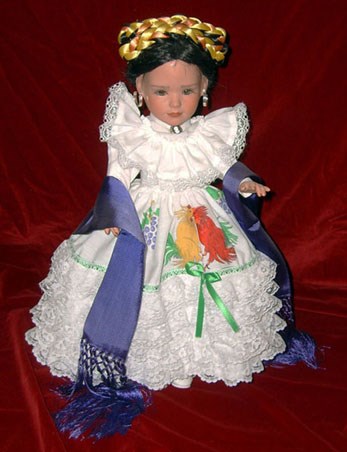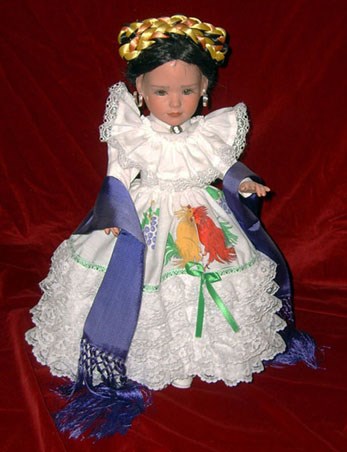
Capital: Aguascalientes Aguascalientes is one of the smallest of the Mexican states, but this distinctive costume rises like a centerpiece from the very heart of Mexico. The high-necked, long-sleeved white blouse reflects Victorian influence, and the full skirt is layered with lace flounces topped by a single green ribbon. The apron is adorned with a pair of bold fighting cocks and a brilliant cluster of grapes, reflecting the state's connection to the land. Long braids, interwoven with orange and yellow ribbons, are worn up in the traditional style, secured by bright bows. With ideal climate and soil conditions, Aguascalientes agriculture yields tons of fine grapes annually, producing delicious raisins, grape juice, and excellent table wines. The state is also known for exquisite handmade articles: extraordinarily beautiful openwork on blouses, dresses, handkerchiefs and tablecloths. The northwestern part of the state is mountainous and heavily forested. Southwestern areas are used for cattle and dairy production, while the central and southeastern lands are dominated by agriculture. The state is known for its fine horses and fighting bulls. Aguascalientes' main tourist event is the annual Feria de San Marcos (San Marcos Fair), where it is said the first cock fights took place. Other attractions include grape and guava fairs, bullfights, parks, gardens, and museums. On December 10, 1914, in the Morelos Theater in the capital city of Aguascalientes, the Plan de Ayala -- a precursor to the 1917 Mexican Constitution -- was first accepted at the Sovereignty Convention of Aguascalientes. Did You Know...? 
Capital: Aguascalientes Aguascalientes, ubicado en el centro de México, es uno de los estados más pequeños y su traje típico es de los más hermosos de la republica. La influencia Victoriana se refleja en la blusa blanca de cuello alto y manga larga; la falda larga con varias capas de encaje se sostiene con un sencillo listón verde. El delantal está adornado por un par gallos de pelea y un brillante racimo de uvas, representando la conexión del estado con la tierra. Las trenzas largas, entretejidas con listones de color naranja y amarillo, son llevadas a la usanza tradicional, atadas con grandes moños. El estado también es conocido por sus exquisitas artesanías hechas a mano: bordados extraordinarios sobre blusas, vestidos, pañuelos y manteles. El noroeste del estado es montañoso y está cubierto por densos bosques. La región del suroeste es utilizada para el ganado y la producción de leche, el centro y sureste están dedicadas a la agricultura. El estado también es famoso por sus finos caballos y toros de lidia. El principal atractivo turístico de Aguascalientes es la Feria de San Marcos, en donde se dice se originaron las peleas de gallos. Otras atracciones son las ferias de la uva y la guayaba, las corridas de toros, los parques, los jardines y los museos. El Plan de Ayala (precursor de la Constitución mexicana de 1917) fue aceptado en la Soberana Convención de Aguascalientes en el Teatro Morelos de la capital del estado el 10 de diciembre de 1914. Sabías qué...? |
Last updated: February 24, 2015
